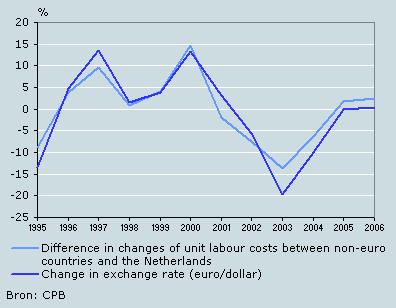Labour costs and competitiveness in the manufacturing industry

The competitiveness of the Dutch manufacturing industry on the non-EU market is related to the labour costs per unit of product. More specifically to the difference in the development of these costs between non-EU countries and the Netherlands. The competitiveness of the low tech sector in particular, and to a slightly lesser extent the medium tech sector, is sensitive to developments in unit labour costs. The high tech sector on the other hand is less sensitive to these developments. In the last ten years differences in the developments of these unit labour costs can nearly all be accounted for by exchange rate effects.
Assessing competitiveness
Unit labour costs are just one of the factors determining the competitiveness of manufacturing companies. This competitiveness improves if unit labour costs for non-euro competitors rise by more than for Dutch manufacturers. Another method to get an insight into competitiveness is to ask manufacturers how they see their competitiveness. Their own assessment corresponds quite well with the development in unit labour costs. Changes in exchange rates are incorporated in the developments of unit labour costs.
In 2000, unit labour costs for non-euro competitors rose by nearly 15 percent more than for Dutch manufacturers. Indeed, the latter assessed their competitiveness as very favourable. On the other hand, a stronger increase in unit labour costs in Dutch manufacturing than elsewhere is accompanied by a negative assessment of competitiveness. This was the case in 2003. The unit labour costs in Dutch manufacturing in this period clearly rose by more than those outside the EU. The opinions of manufacturers reached a low point. After 2003 the assessment of competitiveness improved again. In 2006 manufacturers were reasonably positive about their competitiveness again.
1. Competitiveness and unit labour costs
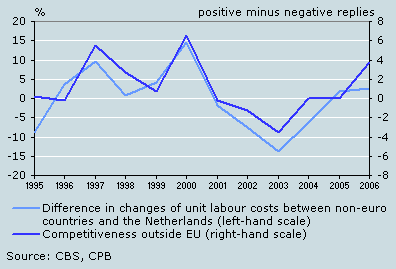
High tech sector least sensitive
The manufacturing industry can be divided into three sectors << linken naar de indeling>>. The low tech sector consists of branches of industry with relatively simple production processes, such as the textile industry and the paper industry. Rubber and plastics belong to the medium tech sector. The high tech sector consist of high grade technical processes such as the production of medical equipment. The division into low, medium, and high tech is based on that by the European Central Bank (ECB).
Manufacturers’ own assessment of their competitiveness outside the EU is quite different in these three sectors. The assessment of manufacturers in the low tech sector follows the same course as the unit labour costs. This sector is thus sensitive to the developments in these costs. This is slightly less so for the medium tech sector.
The assessment of competitiveness in the high tech sector on the other hand fluctuates clearly less than the development in unit labour costs. Moreover, the curves deviate from each other. This sector is less sensitive to developments in unit labour costs. Apparently the high tech competes on the basis of other aspects.
2. Competitiveness on the non-EU market
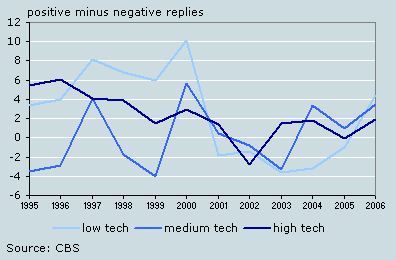
Exchange rate has most effect on competitiveness
Between countries with the same currency, developments in wage bases and labour productivity determine the differences in the unit labour costs. When comparing countries with different currencies, the exchange rate between the currencies also has an effect. The difference in development of wage bases between the Netherlands and non-EU countries has never been higher than 5 percent in the last ten years. The same is true for labour productivity. The exchange rate (euro/dollar) showed much larger variation in this period.
3. Wage base
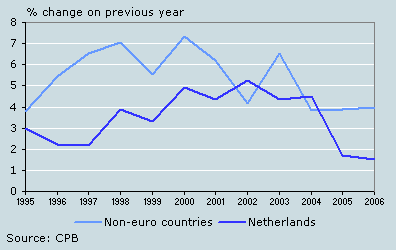
4. Labour productivity
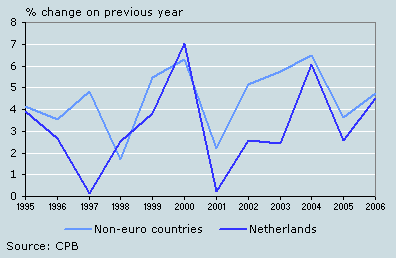
In 1997 the euro lost nearly 14 percent value on the dollar. Conversely, in 2003 the value of the euro rose by nearly 20 percent compared with the dollar. The fluctuations in the exchange rate are much greater than developments in the wage base and labour productivity. The difference in development of the unit labour costs between non-euro countries and the Netherlands is indeed nearly entirely accounted for by fluctuations in the exchange rate in this period.
5. Exchange rate and unit labour costs
